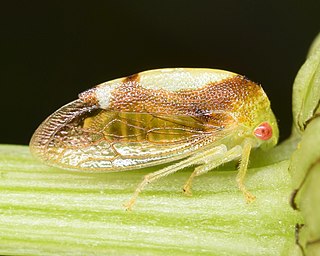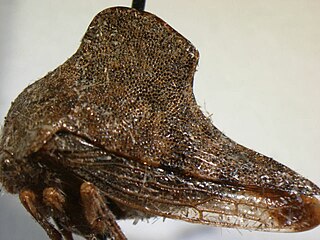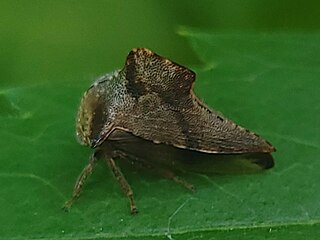
Treehoppers and thorn bugs are members of the family Membracidae, a group of insects related to the cicadas and the leafhoppers. About 3,200 species of treehoppers in over 400 genera are known. They are found on all continents except Antarctica; only five species are known from Europe. Individual treehoppers usually live for only a few months.

Coleophora is a very large genus of moths of the family Coleophoridae. It contains some 1,350 described species. The genus is represented on all continents, but the majority are found in the Nearctic and Palaearctic regions. Many authors have tried splitting the genus into numerous smaller ones, but most of these have not become widely accepted.

The buffalo treehopper is a species of treehopper belonging to the subfamily Smiliinae. It is sometimes classified as Ceresa bisonia.

Enchenopa binotata is a complex of multiple species found mostly in Eastern North America, but have also been reported in Central America. They are commonly referred to as treehoppers and are sap-feeding insects. The species in the complex look similar to each other in morphology, but are identified as different species by the host plant they occupy.

Aetalionidae are a family of treehoppers in the superfamily Membracoidea. Aetalionidae are somewhat like Membracidae in that they have one to three rows of short spines on the hind tibia but differ in having the front femur fused to the trochanter and the scutellum is completely exposed. The females have finger-like protrusions on the genital capsule. The family is mostly Neotropical. The subfamily Biturritiinae is Neotropical while the subfamily Aetalioninae has a Neotropical genus Aetalion and the sole Old World representative genus Darthula with a single species Darthula hardwickii.

Smiliinae is a subfamily of treehoppers in the family Membracidae. These are bugs and include about 100 genera in 10 tribes.

Kaikaia is a genus of treehopper endemic to Nicaragua, containing the single species Kaikaia gaga. It was described in 2020 by Brendan Morris, a Ph.D. student at the University of Illinois at Urbana-Champaign. It entered the news when it was revealed that the insect was named after Lady Gaga.

Atymna is a genus of treehoppers in the family Membracidae.

Hebetica sylviae is a member of the treehopper family Membracidae. It is found in the eastern United States, first discovered in Murray, Kentucky, with a second sighting in Atlanta, Georgia.

Telamona agrandata is a species of treehopper in the genus Telamona.

Telamona ampelopsidis, also known as the Virginia creeper treehopper, is one of the 38 species of treehopper in the genus Telamona.

Carynota mera is a species of treehopper. It belongs to the genus Carynota in the family Membracidae. It was first described by Thomas Say in 1830 as Membracis mera.

Cyrtolobus tuberosus is a species of treehopper belonging to the genus Cyrtolobus. It was first described by Léon Fairmaire in 1846 as Thelia tuberosa. It is the largest treehopper in the Cyrtolobus genus, 9-10mm for females and 7-8mm for males
Vanduzea triguttata, also known as the three-spotted treehopper, is a species of treehopper belonging to the genus Vanduzea. It was first described by the German entomologist Ernst-Gerhard Burmeister in 1836.
Grandolobus is a genus of treehoppers in the subfamily Smiliinae.
Bajiilata is a genus of treehoppers belonging to the tribe Amastrlni in the subfamily Smillinae. It is monotypic, being represented by the single species, Bajulata bajuIa.
Idioderma is a genus of treehoppers belonging to the tribe Amastrini.
Sayiana is a genus of planthoppers belonging to the subfamily Otiocerinae.

Smilia camelus, also known as the camel treehopper, is a species of treehopper first described by Johan Christian Fabricius in 1803.
Smilia fasciata is a species of treehopper belonging to the family Membracidae. It was first described by Charles Jean-Baptiste Amyot and Jean Guillaume Audinet-Serville in 1843.














